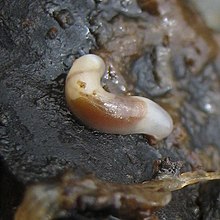Smeagol is a genus of small air-breathing[2] sea slugs of the upper intertidal zone.[3] They are pulmonate gastropod mollusks related to land slugs and snails.
| Smeagol | |
|---|---|

| |
| Smeagol climoi on seaweed buried in gravel, Houghton Bay, Wellington | |
| Scientific classification | |
| Kingdom: | |
| Phylum: | |
| Class: | |
| (unranked): | |
| Superfamily: | |
| Family: | Pfeiffer, 1854
|
| Genus: | Smeagol Climo, 1980[1]
|
| Diversity | |
| 5 or 6 species | |
Analysis of DNA sequences has shown that Smeagol belongs in the family Ellobiidae, and is therefore closely related to ellobiid snails.[4]
Etymology edit
The name of the genus is in honour of Tolkien's fictional character Gollum, who was originally known as Sméagol.[1]
Taxonomy edit
There are five described species[5] and potentially one undescribed species from Tasmania[6] in the genus Smeagol:
Anatomy edit
Smeagol manneringi has no tentacles and is a very active blind animal with a size of up to 10 mm.[1]
Smeagol species have no shell. They have a weakly developed snout.[2] The radula is unicuspid[1] and the radular dentition is of the rhipidoglossate type.[2] They have a radular membrane of flexoglossate type.[2] They have no jaw.[1][2] They have salivary glands with salivary ducts.[2]
The excretory organs are only the left ones, in the pallial cavity.[2] In the circulatory system the haemolymph circulates as follows: mantle → nephridium or nephridia[clarification needed] → heart.[2]
These slugs breathe using a pallial lung.[1] They have a contractile pneumostome.[2]
They have a suprapedal gland.[2]
The number of chromosomes is unknown.[2] They have no sex chromosomes.[2]
Distribution edit
The genus Smeagol is so far restricted to New Zealand and Australia.[1] Smeagol manneringi is known from the south coast of Wellington, and in a possibly genetically distinct form from Kaikoura.[7]
Ecology edit
These slugs inhabit the upper intertidal zone on gravel substrate.[5]
The development of the veliger is completed in the egg (they do not have a trochophore larval stage).[2]
References edit
- ^ a b c d e f g Climo, F. M. (1980). "Smeagolida, a new order of gymnomorph mollusc from New Zealand based on a new genus and species". New Zealand Journal of Zoology. 7 (4): 513–522. doi:10.1080/03014223.1980.11760683.
- ^ a b c d e f g h i j k l m Barker G. M. (2001) Gastropods on Land: Phylogeny, Diversity and Adaptive Morphology. 1-146. In: Barker G. M. (ed.) (2001) The biology of terrestrial molluscs. CABI Publishing, Oxon, UK, cited pages: 52, 127-134. ISBN 0-85199-318-4.
- ^ Marshall, B.; Rosenberg, G. (2016). Smeagol Climo, 1980. In: MolluscaBase (2017). Accessed through: World Register of Marine Species at http://www.marinespecies.org/aphia.php?p=taxdetails&id=551549 on 2017-09-13
- ^ Dayrat, Benoît; Conrad, Michele; Balayan, Shaina; White, Tracy R.; Albrecht, Christian; Golding, Rosemary; Gomes, Suzete R.; Harasewych, M.G.; Martins, António Manuel de Frias (2011). "Phylogenetic relationships and evolution of pulmonate gastropods (Mollusca): New insights from increased taxon sampling". Molecular Phylogenetics and Evolution. 59 (2): 425–437. doi:10.1016/j.ympev.2011.02.014. PMID 21352933.
- ^ a b c d e f g Tillier, S.; Ponder, W. F. (1992). "New species of Smeagol from Australia and New Zealand, with discussion of the affinities of the genus (Gastropoda: Pulmonata)". Journal of Molluscan Studies. 58 (2): 135–155. doi:10.1093/mollus/58.2.135.
- ^ West R. (February 2009). Proposed determination Smeagol hilaris, a marine slug, as a critically endangered species. Fisheries Scientific Committee, Ref. No. PD43, File No. FSC 09/01, 3 pp., PDF.
- ^ "Rare 'gravel maggot' found on remote West Coast beach". 1 News. 13 May 2022. Retrieved 2022-05-16.
Further reading edit
- Haszprunar, G.; Huber, G. (1990). "On the central nervous system of Smeagolidae and Rhodopidae, two families questionably allied with the Gymnomorpha (Gastropoda: Euthyneura)". Journal of Zoology. 220 (2): 185–199. doi:10.1111/j.1469-7998.1990.tb04302.x.
- Romero, P. E.; Pfenninger, M.; Kano, Y.; Klussmann-Kolb, A. (2016). "Molecular phylogeny of the Ellobiidae (Gastropoda: Panpulmonata) supports independent terrestrial invasions". Molecular Phylogenetics and Evolution. 97: 43–54. doi:10.1016/j.ympev.2015.12.014. PMID 26724408.
External links edit
- Smeagol discussed on RNZ Critter of the Week, 17 September 2015